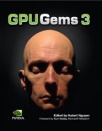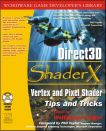I’m at I3D 2009; tonight at the dinner Austin Robison at NVIDIA announced NVIRT, which is NVIDIA’s ray-casting engine. I say “casting” as the idea is that you feed it objects, hand it a ray generator and it gives you back the ray intersections desired. Certainly it can be used for ray traced rendering, and the constructs presented make it clear they have thought through this aspect: rays can terminate on the first intersection found (useful for shadow rays), or can return the closest intersection point (eye/reflection/refraction rays). Rays can continue on when a fully transparent object is hit. Objects can be put in any efficiency structure you wish, and structures could be contained by other structures (Jim Arvo’s metahierachies idea). For example, you could put static geometry in a k-d tree, which is highly efficient but expensive to update, while placing dynamic objects in a bounding volume hierarchy, which usually can be updated more easily (though losing efficiency over time) by growing bounds. You have control over what efficiency methods are used.
They’re thinking of this SDK in more general ray-casting terms: collision detection, AI queries, and baking illumination or other characteristics onto surfaces. I can certainly imagine uses for engineering simulation. It runs on CUDA, but hides CUDA programming from the user. By the way, the switching time between CUDA and the graphics API will someday soon be a lot less that it is now.
This SDK will be released sometime this Spring (it will also be incorporated with NVIDIA’s NVSG scene graph SDK, as a separate release). The SDK will come with lots of samples, including source fo a basic ray-tracing renderer. All in all, an interesting development. The catch is, of course, that CUDA does not run on anything but NVIDIA hardware. Nonetheless, this is a fascinating first step. Austin says this effort is a serious attempt by NVIDIA to put this sort of engine in the hands of developers, not some “let’s see if this research sticks” half-baked release. Hearing him talk about the bits of inside information their group learnt about the operation of the GPU, and the corresponding boosts in performance, makes me wonder if other GPU-based ray tracers out there will be able to get near their performance.
I have a bunch of links saved up, which I’ll dump here someday soon, as well as more about I3D 2009 (see Jeremy Schopf’s blog in the meantime). For now I’ll just mention one quick link: Morgan McGuire’s twitter blog. No, it’s not a “I’m drinking a latte and using my iPhone” twitter blog. I like the idea a lot: it’s where he simply puts any great links he’s run across, with a quick description for each. Low maintenance, minimal effort, and useful & interesting, at least to me. It’s about game design and related topics (and unrelated ones) as much as graphics. This is one of those “everyone who finds cool stuff on the internet should do this” concepts, as far as I’m concerned. Sure, there’s del.icio.us and similar social bookmarking sites, but a blog lets me know when there’s something new from someone I respect.
Morgan is one of those uncommon people who has considerable industry experience (e.g. “Titan Quest”) while also being in the academic world. He’s a coauthor of the new book Creating Games, which I had been jumping around inside and sampling snippets, and am now sitting down and reading for real. It is aimed at being a book for teaching a college course on making games, both board- and video-, giving a number of schedules for 3 to 4 week projects and worksheets for these. However, these are appendices; the focus of the book is well-informed surveys of a wide range of game design and creation practices. The first chapter has a great startup project for small groups in a class: “here are some dice and pieces of different colors, some paper – go, make a game in 7 minutes.” Anyway, not graphics related per se, but there’s certainly a lot about the computer games industry inside, much of it technical and practical. My favorite illustration so far is the dependence graph amongst the art assets for Spiderman 3, Figure 3.8 – daunting. You can look inside at Amazon. Me, I’m an avid boardgamer (I was up too late last night playing Dominion with Morgan and Naty Hoffman – consider me entirely biased), so I’m enjoying reading it and thinking maybe I should try to design a game…

